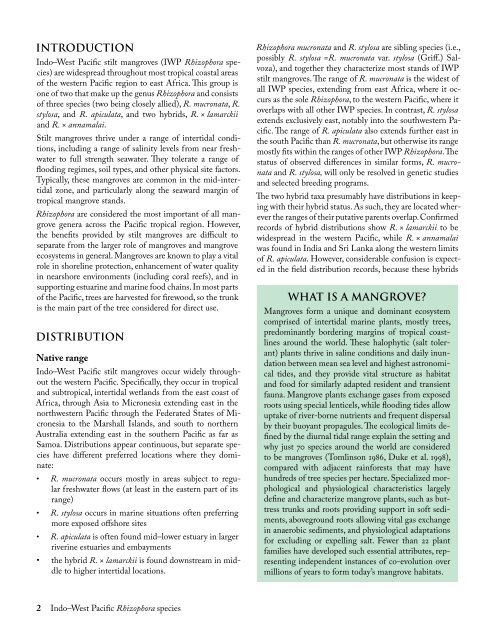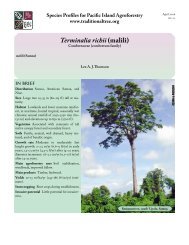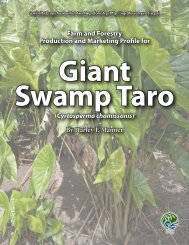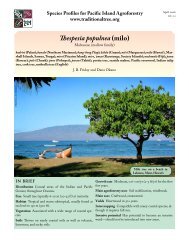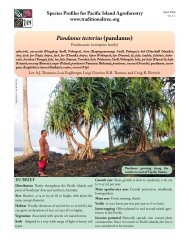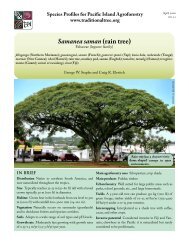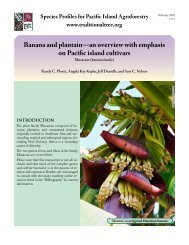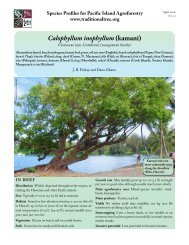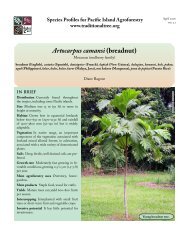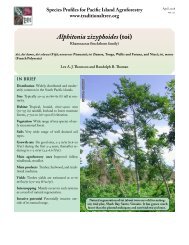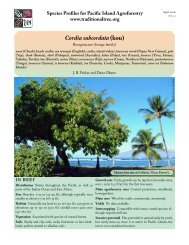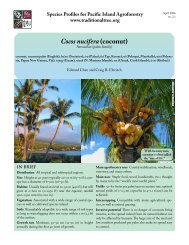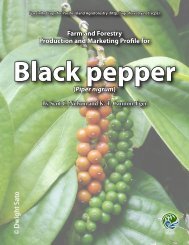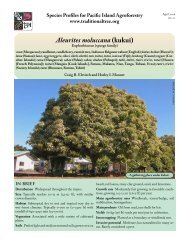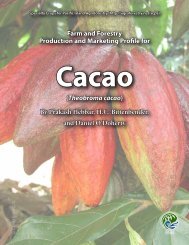Rhizophora apiculata, R. mucronata, R. stylosa, R ... - Agroforestry Net
Rhizophora apiculata, R. mucronata, R. stylosa, R ... - Agroforestry Net
Rhizophora apiculata, R. mucronata, R. stylosa, R ... - Agroforestry Net
Create successful ePaper yourself
Turn your PDF publications into a flip-book with our unique Google optimized e-Paper software.
INTRODUCTION<br />
Indo–West Pacific stilt mangroves (IWP <strong>Rhizophora</strong> species)<br />
are widespread throughout most tropical coastal areas<br />
of the western Pacific region to east Africa. This group is<br />
one of two that make up the genus <strong>Rhizophora</strong> and consists<br />
of three species (two being closely allied), R. <strong>mucronata</strong>, R.<br />
<strong>stylosa</strong>, and R. <strong>apiculata</strong>, and two hybrids, R. × lamarckii<br />
and R. × annamalai.<br />
Stilt mangroves thrive under a range of intertidal conditions,<br />
including a range of salinity levels from near freshwater<br />
to full strength seawater. They tolerate a range of<br />
flooding regimes, soil types, and other physical site factors.<br />
Typically, these mangroves are common in the mid-intertidal<br />
zone, and particularly along the seaward margin of<br />
tropical mangrove stands.<br />
<strong>Rhizophora</strong> are considered the most important of all mangrove<br />
genera across the Pacific tropical region. However,<br />
the benefits provided by stilt mangroves are difficult to<br />
separate from the larger role of mangroves and mangrove<br />
ecosystems in general. Mangroves are known to play a vital<br />
role in shoreline protection, enhancement of water quality<br />
in nearshore environments (including coral reefs), and in<br />
supporting estuarine and marine food chains. In most parts<br />
of the Pacific, trees are harvested for firewood, so the trunk<br />
is the main part of the tree considered for direct use.<br />
DISTRIBUTION<br />
Native range<br />
Indo–West Pacific stilt mangroves occur widely throughout<br />
the western Pacific. Specifically, they occur in tropical<br />
and subtropical, intertidal wetlands from the east coast of<br />
Africa, through Asia to Micronesia extending east in the<br />
northwestern Pacific through the Federated States of Micronesia<br />
to the Marshall Islands, and south to northern<br />
Australia extending east in the southern Pacific as far as<br />
Samoa. Distributions appear continuous, but separate species<br />
have different preferred locations where they dominate:<br />
•<br />
•<br />
•<br />
•<br />
R. <strong>mucronata</strong> occurs mostly in areas subject to regular<br />
freshwater flows (at least in the eastern part of its<br />
range)<br />
R. <strong>stylosa</strong> occurs in marine situations often preferring<br />
more exposed offshore sites<br />
R. <strong>apiculata</strong> is often found mid–lower estuary in larger<br />
riverine estuaries and embayments<br />
the hybrid R. × lamarckii is found downstream in middle<br />
to higher intertidal locations.<br />
Indo–West Pacific <strong>Rhizophora</strong> species<br />
<strong>Rhizophora</strong> <strong>mucronata</strong> and R. <strong>stylosa</strong> are sibling species (i.e.,<br />
possibly R. <strong>stylosa</strong> =R. <strong>mucronata</strong> var. <strong>stylosa</strong> (Griff.) Salvoza),<br />
and together they characterize most stands of IWP<br />
stilt mangroves. The range of R. <strong>mucronata</strong> is the widest of<br />
all IWP species, extending from east Africa, where it occurs<br />
as the sole <strong>Rhizophora</strong>, to the western Pacific, where it<br />
overlaps with all other IWP species. In contrast, R. <strong>stylosa</strong><br />
extends exclusively east, notably into the southwestern Pacific.<br />
The range of R. <strong>apiculata</strong> also extends further east in<br />
the south Pacific than R. <strong>mucronata</strong>, but otherwise its range<br />
mostly fits within the ranges of other IWP <strong>Rhizophora</strong>. The<br />
status of observed differences in similar forms, R. <strong>mucronata</strong><br />
and R. <strong>stylosa</strong>, will only be resolved in genetic studies<br />
and selected breeding programs.<br />
The two hybrid taxa presumably have distributions in keeping<br />
with their hybrid status. As such, they are located wherever<br />
the ranges of their putative parents overlap. Confirmed<br />
records of hybrid distributions show R. × lamarckii to be<br />
widespread in the western Pacific, while R. × annamalai<br />
was found in India and Sri Lanka along the western limits<br />
of R. <strong>apiculata</strong>. However, considerable confusion is expected<br />
in the field distribution records, because these hybrids<br />
WHAT IS A MANGROVE?<br />
Mangroves form a unique and dominant ecosystem<br />
comprised of intertidal marine plants, mostly trees,<br />
predominantly bordering margins of tropical coastlines<br />
around the world. These halophytic (salt tolerant)<br />
plants thrive in saline conditions and daily inundation<br />
between mean sea level and highest astronomical<br />
tides, and they provide vital structure as habitat<br />
and food for similarly adapted resident and transient<br />
fauna. Mangrove plants exchange gases from exposed<br />
roots using special lenticels, while flooding tides allow<br />
uptake of river-borne nutrients and frequent dispersal<br />
by their buoyant propagules. The ecological limits defined<br />
by the diurnal tidal range explain the setting and<br />
why just 70 species around the world are considered<br />
to be mangroves (Tomlinson 1986, Duke et al. 1998),<br />
compared with adjacent rainforests that may have<br />
hundreds of tree species per hectare. Specialized morphological<br />
and physiological characteristics largely<br />
define and characterize mangrove plants, such as buttress<br />
trunks and roots providing support in soft sediments,<br />
aboveground roots allowing vital gas exchange<br />
in anaerobic sediments, and physiological adaptations<br />
for excluding or expelling salt. Fewer than 22 plant<br />
families have developed such essential attributes, representing<br />
independent instances of co-evolution over<br />
millions of years to form today’s mangrove habitats.


